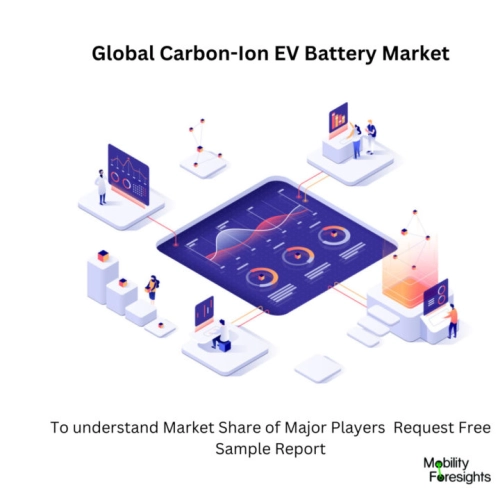
- Get in Touch with Us

Last Updated: Apr 25, 2025 | Study Period: 2024-2030
Fast, clean electricity on demand is made possible by the special characteristics of carbon-ion cells, which enable them to charge and discharge incredibly quickly while yet maintaining significant energy storage. The C-Ion technology, which was initially created for grid energy storage, can also be used to strengthen and bolster the electrical grid, supporting a new range of chargers that operate at 350kW to 1,500kW, which is 10 times quicker than the current superchargers.
In batteries, carbon can be utilised to make reticulated current collectors. The weight of batteries is reduced when heavy lead grids are replaced with carbon collectors, which increases the battery's specific energy. There is a significant discrepancy between the lead-acid battery's theoretical specific energy and which is 168 Wh kg1, and the average amount acquired is between 30 and 40 Wh kg1. One of the causes is the inefficient use of lead, which makes up 67% of the weight of batteries.
The heavy lead grid serves only as a mechanical support and current collector and is not involved in the redox processes that occur in batteries. Despite this, it may account for 33-50% of the plate's weight and about 25% of the battery's overall mass. Just 40â50% of the active mass is used during a discharge with 0.1C current, and during this time, lead oxide converts into sulphate. Around 65â75% of the battery's total mass of lead is not involved in electrochemical processes that produce electricity.
One of the problems facing battery makers is the need to improve these properties. Reticulated collectors can be used in place of metal grids to improve active mass consumption. The coefficient, which measures the mass of the paste to the collector surface area, typically ranges between 2 and 2.5 g cm2.
As compared to similar plate sizes when employing the new reticulated collectors, value can equal 0.25 g cm2. The coefficient's lower value is correlated with higher active mass utilisation, higher discharge capacity, and lower current flow densities. Moreover, reticulated collectors provide the active mass with superior mechanical support, extending the battery's cycle life.

The Global Carbon-Ion EV Battery market accounted for $XX Billion in 2023 and is anticipated to reach $XX Billion by 2030, registering a CAGR of XX% from 2024 to 2030.
ZapGo launched a Carbon-Ion EV Battery with new technology With a 350-mile range comparable to conventional combustion engine vehicles, ZapGo Ltd's unique Carbon-Ion platform technology offers the possibility of charging electric vehicles in five minutes.
This new type of battery is safer and less expensive than existing battery technologies. The solid-state C-Ion cells from ZapGo are safer and more affordable because they don't include lithium or cobalt. C-Ion cells can't catch fire since there isn't anything inside that would burn, and the ionic electrolytes work as a fire suppressant. They only use a new kind of ionic electrolyte and an enhanced kind of carbon.
At the end of their useful lives, the advanced materials inside can likewise be recycled. The structural elements of a vehicle, like as the chassis and panels, can be bundled with C-Ion cells to enable the vehicle to securely take charge at this pace.
This technique has already been put to the test on an autonomous vehicle by ZapGo, which charges it 100 times faster than conventional EVs can in just 35 seconds. The C-Ion technology, which was initially created for grid energy storage, can also be used to strengthen and bolster the electrical grid, supporting a new range of chargers that operate at 350kW to 1,500kW, which is 10 times quicker than the current superchargers.
| Sl no | Topic |
| 1 | Market Segmentation |
| 2 | Scope of the report |
| 3 | Abbreviations |
| 4 | Research Methodology |
| 5 | Executive Summary |
| 6 | Introduction |
| 7 | Insights from Industry stakeholders |
| 8 | Cost breakdown of Product by sub-components and average profit margin |
| 9 | Disruptive innovation in the Industry |
| 10 | Technology trends in the Industry |
| 11 | Consumer trends in the industry |
| 12 | Recent Production Milestones |
| 13 | Component Manufacturing in US, EU and China |
| 14 | COVID-19 impact on overall market |
| 15 | COVID-19 impact on Production of components |
| 16 | COVID-19 impact on Point of sale |
| 17 | Market Segmentation, Dynamics and Forecast by Geography, 2024-2030 |
| 18 | Market Segmentation, Dynamics and Forecast by Product Type, 2024-2030 |
| 19 | Market Segmentation, Dynamics and Forecast by Application, 2024-2030 |
| 20 | Market Segmentation, Dynamics and Forecast by End use, 2024-2030 |
| 21 | Product installation rate by OEM, 2023 |
| 22 | Incline/Decline in Average B-2-B selling price in past 5 years |
| 23 | Competition from substitute products |
| 24 | Gross margin and average profitability of suppliers |
| 25 | New product development in past 12 months |
| 26 | M&A in past 12 months |
| 27 | Growth strategy of leading players |
| 28 | Market share of vendors, 2023 |
| 29 | Company Profiles |
| 30 | Unmet needs and opportunity for new suppliers |
| 31 | Conclusion |
| 32 | Appendix |